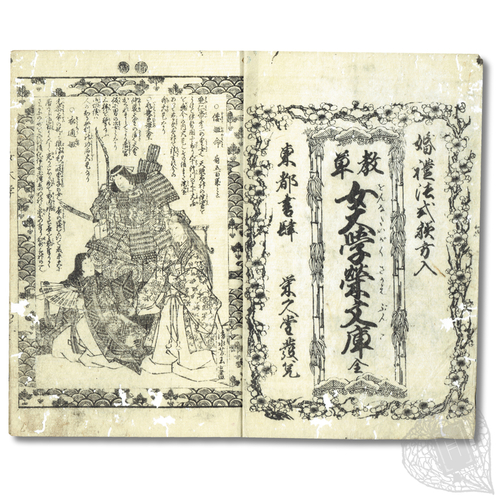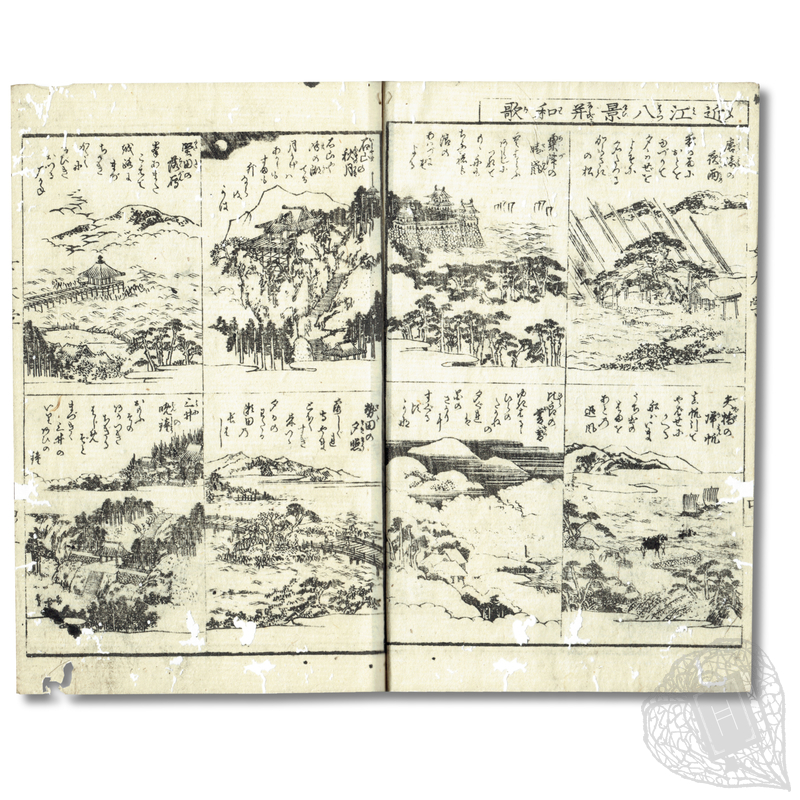Classic Illustrated Books Modern Art and Design Books Translations of Western Texts Japanese Literature Prints and Ephemera Western Books Photo Books Paintings & Scrolls Australia & New Zealand Others
Australia New Zealand Antarctica Japan Korea China Other
Edo Period [1603-1853] Bakumatsu Period [1853-1868] Meiji Period [1868-1912] Taishō Period [1912-1926] Shōwa Period [1926-1989]
Share this book on...

Oshiegusa Onna Daigaku Sakae Bunko (Lessons for Women: Library of Honour)
 ENQUIRE ENQUIRE |
Oshiegusa Onna Daigaku Sakae Bunko ["Lessons for Women: Library of Honour"]
Shimizu, Yoshitamajo [illustrated by].
Edo [Tōkyō]: Eikyūdō, Kaei 4 [1851].
A manual of conduct for women, illustrated by Shimizu Yoshitamajo, also known as Utagawa Yoshitama (1836-1870). Yoshitama was a pupil of Utagawa Kuniyoshi and later became a pupil of Shibata Zeshin. Aside from creating draft illustrations for Zeshin and executing the colouring of Kuniyoshi's drafts, she produced illustrations for books, ukiyo-e, fans, and sugoroku. Although women artists contributed illustrations to printed books in the Edo period, their illustrations were often unsigned or attributed to their teachers (who were usually male artists). Yoshitamajo is one of the few women artists of the Edo period to have her name explicitly recorded as an illustrator in printed books she contributed to. The illustration on the first page of text gives her printed signature. The ex-owner, a woman, has inscribed her name on both wrappers.
Onna Daigaku were instructional texts for women produced in the Edo period to reinforce appropriate female attitudes and behaviours as well as to teach relevant skills. The textbooks often included information on "demarcation between the sexes, reasons for divorce, and responsibilities of married women".¹ While Onna Daigaku were often used as presents for newly-wed brides, they were also used at terakoya (private elementary schools) and in the homes of wealthy families as books from which girls could copy phrases to improve their handwriting (the calligraphic text in the lower panel of Onna Daigaku was largely carved for this purpose). There were many different types of Onna Daigaku, but most were based on Onna Daigaku Takarabako, a text published around 1729 and attributed to botanist and Neo-Confucianist Kaibara Ekken (1630-1714). Scholars now estimate that "more than 45,000 copies of the text circulated during the latter half of the Edo period",² a huge distribution that makes Onna Daigaku "extremely valuable for investigating what sort of views of women were common during and after the mid-Edo period".³
One four-hole-bound (yotsumetoji) volume, complete, on double leaves, traditional East Asian binding style (fukurotoji). Original wrappers worn and marked, inscribed by ex-owner. Considerable wormholing throughout. Occasional ink marks internally. 5, 28 leaves. 25.5 x 17.2 cm.
1. E. Lillehoj, "Properly Female: Illustrated Books of Morals for Women in Edo Japan", in M. Bose (ed.), Women, Gender and Art in Asia, c. 1500-1900, New York, Routledge, Taylor & Francis Group, 2018, p. 245.
2. Lillehoj, "Properly Female", p. 245.
3. S. Koyama, Ryōsai Kenbo: The Educational Ideal of "Good Wife, Wise Mother" in Modern Japan, Leiden, BRILL, 2012, p. 13.
# 240629-9


• Ask a question about this item >
Classic Illustrated Books Modern Art and Design Books Translations of Western Texts Japanese Literature Prints and Ephemera Western Books Photo Books Paintings & Scrolls Australia & New Zealand Others
Australia New Zealand Antarctica Japan Korea China Other
Edo Period [1603-1853] Bakumatsu Period [1853-1868] Meiji Period [1868-1912] Taishō Period [1912-1926] Shōwa Period [1926-1989]
Share this book on...













